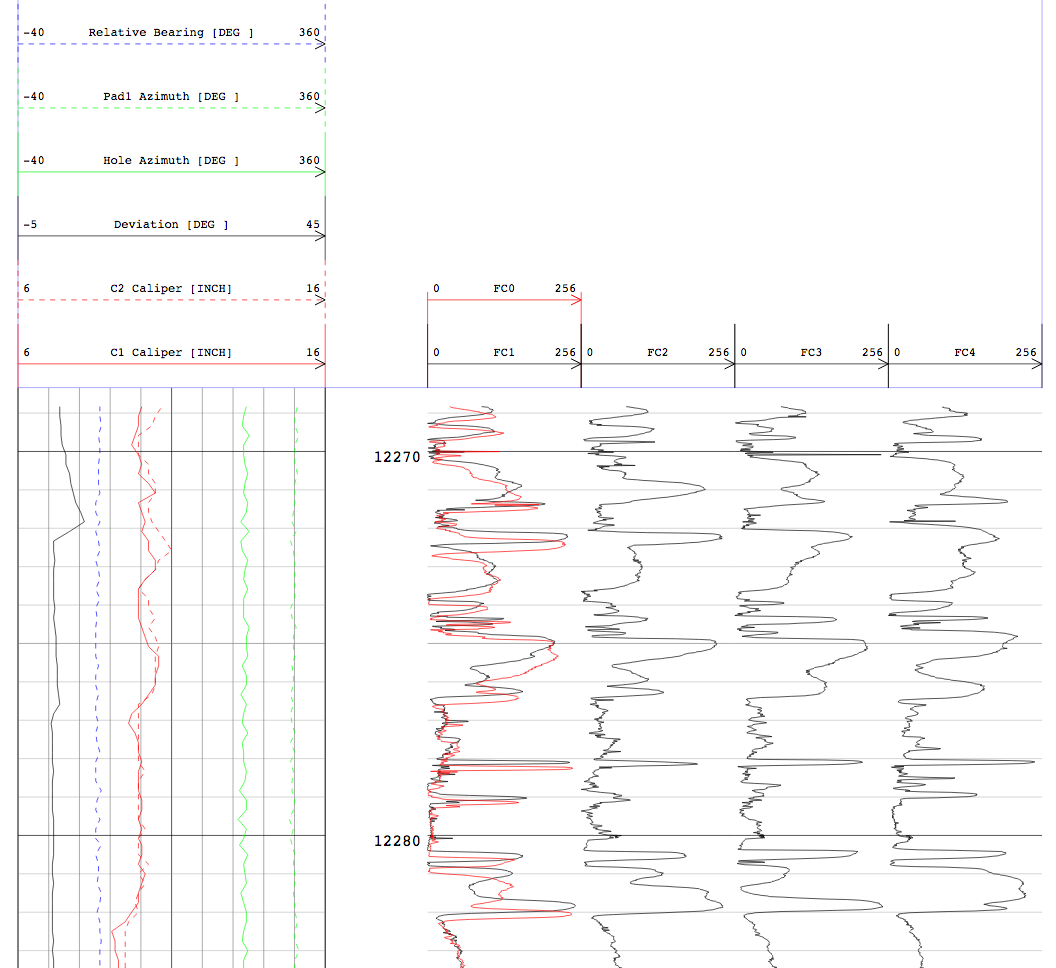

Petrophysical software capable of processing wireline logs.
- Free software: GPL 2.0
- Documentation: https://TotalDepth.readthedocs.io
- Reads LIS, LAS (1.2, 2.0), RP66V1 (DLIS), Western Atlas BIT, and DAT Mud Log file formats for analysis or conversion to other formats.
- Creates Numpy arrays of log data.
- Plots log data as SVG viewable in any modern browser.
- Plots can be made with a wide variety of plot formats.
- TotalDepth can generate HTML summaries of log data.
- TotalDepth is written in Python so it is fast to develop with.
- Special indexing techniques are used to be able to randomly access sequential files.
Here is an example of a LAS file plotted with the Triple Combo plot format as seen in a browser which includes the API header:
An example of a High Resolution Dipmeter plotted at 1:25 scale:
Here is an example of accessing RP66V1 (DLIS) data as a numpy array and using np.info() to describe each array:
import numpy as np
from TotalDepth.RP66V1.core import LogicalFile
# path_in is expected to be the path to a RP66V1 file.
# Try this with an example RP66V1 file at TotalDepth/example_data/RP66V1/data/206_05a-_3_DWL_DWL_WIRE_258276498.DLIS
with LogicalFile.LogicalIndex(path_in) as logical_index:
for logical_file in logical_index.logical_files:
if logical_file.has_log_pass:
for frame_array in logical_file.log_pass:
print(frame_array)
frame_count = logical_file.populate_frame_array(frame_array)
print(
f'Loaded {frame_count} frames and {len(frame_array)} channels'
f' from {frame_array.ident} using {frame_array.sizeof_array} bytes.'
)
for channel in frame_array.channels:
print(channel)
# channel.array is a numpy array
np.info(channel.array)
print()The output will be something like:
FrameArray: ID: OBNAME: O: 2 C: 0 I: b'2000T' b''
<FrameChannel: 'TIME' "b'1 second River Time'" units: 'b'ms'' count: 1 dimensions: (1,) frames: 1>
<FrameChannel: 'TDEP' "b'1 second River Depth'" units: 'b'0.1 in'' count: 1 dimensions: (1,) frames: 0>
<FrameChannel: 'TENS_SL' "b'Cable Tension'" units: 'b'lbf'' count: 1 dimensions: (1,) frames: 0>
<FrameChannel: 'DEPT_SL' "b'Station logging depth'" units: 'b'0.1 in'' count: 1 dimensions: (1,) frames: 0>
Loaded 921 frames and 4 channels from OBNAME: O: 2 C: 0 I: b'2000T' using 14736 bytes.
<FrameChannel: 'TIME' "b'1 second River Time'" units: 'b'ms'' count: 1 dimensions: (1,) frames: 921>
class: ndarray
shape: (921, 1)
strides: (4, 4)
itemsize: 4
aligned: True
contiguous: True
fortran: True
data pointer: 0x102a08a00
byteorder: little
byteswap: False
type: float32
<FrameChannel: 'TDEP' "b'1 second River Depth'" units: 'b'0.1 in'' count: 1 dimensions: (1,) frames: 921>
class: ndarray
shape: (921, 1)
strides: (4, 4)
itemsize: 4
aligned: True
contiguous: True
fortran: True
data pointer: 0x102a09a00
byteorder: little
byteswap: False
type: float32
<FrameChannel: 'TENS_SL' "b'Cable Tension'" units: 'b'lbf'' count: 1 dimensions: (1,) frames: 921>
class: ndarray
shape: (921, 1)
strides: (4, 4)
itemsize: 4
aligned: True
contiguous: True
fortran: True
data pointer: 0x102a0aa00
byteorder: little
byteswap: False
type: float32
<FrameChannel: 'DEPT_SL' "b'Station logging depth'" units: 'b'0.1 in'' count: 1 dimensions: (1,) frames: 921>
class: ndarray
shape: (921, 1)
strides: (4, 4)
itemsize: 4
aligned: True
contiguous: True
fortran: True
data pointer: 0x102a0ba00
byteorder: little
byteswap: False
type: float32
...To install TotalDepth, run this command in your terminal:
$ pip install TotalDepthThis is the preferred method to install TotalDepth, as it will always install the most recent stable release from PyPi.
If you don't have pip installed, this Python installation guide can guide you through the process.
If you are using a virtual environment in your virtual environment directory, for example ~/pyvenvs:
$ python3 -m venv ~/pyvenvs/TotalDepth
$ source ~/pyvenvs/TotalDepth/bin/activate
(TotalDepth) $Or if you have a Conda environment (here using Python 3.8, adjust as necessary):
$ conda create --name TotalDepth python=3.8 pip
$ source activate TotalDepthInstall the dependencies, numpy and Cython:
If you are using a virtual environment:
(TotalDepth) $ pip install numpy
(TotalDepth) $ pip install CythonOr if you have a Conda environment:
(TotalDepth) $ conda install numpy
(TotalDepth) $ conda install CythonThe sources for TotalDepth can be downloaded from the Github repo.
You can either clone the public repository:
(TotalDepth) $ git clone git://github.com/paulross/TotalDepth.gitOr download the tarball:
(TotalDepth) $ curl -OL https://github.com/paulross/TotalDepth/tarball/masterOnce you have a copy of the source, you can install it with:
(TotalDepth) $ cd TotalDepth
(TotalDepth) $ python setup.py installInstall the test dependencies and run TotalDepth's tests:
(TotalDepth) $ pip install pytest
(TotalDepth) $ pip install pytest-runner
(TotalDepth) $ python setup.py testThis package was created with Cookiecutter and the audreyr/cookiecutter-pypackage project template.

